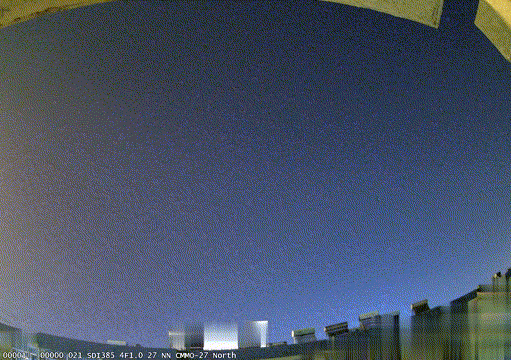CME MISSES EARTH: There's still no sign of a CME expected to hit Earth yesterday, Aug. 20th. It probably missed. The CME did hit NASA's STEREO-A spacecraft. The geometry of the STEREO-A impact suggests that the storm cloud sailed wide of our planet.
Original Story:
Magnetic Solar Storm To Strike Earth
A CME IS COMING: High-latitude sky watchers should be alert for auroras on Thursday, August 20. 20th when a CME (coronal mass ejection) is expected to graze Earth's magnetic field. Launched into space on Aug. 16th by a slow-motion solar flare, the CME is not heading directly for Earth. Nevertheless, NOAA models of the CME suggest that a glancing blow is likely. Storm levels could reach category G1.

Such an event in the past has caused communications failures in remote parts of the southwest deserts and Baja Mexico.
Space weather experts at NASA and NOAA are warning that a solar storm could strike Earth on Thursday or Friday; in addition to triggering aurora far from the poles, a strong solar storm could also disrupt electrical generation systems, the electric grid, satellite communications, and radio signals.
Space weather physicist Dr. Tamitha Skov said aurora is possible in the mid-latitudes, which are typically at 30-60 degrees. Skov Tweeted,
“This solar storm could bring aurora down to places like the United Kingdom’s Northumberland and Norfolk, United States’ Maine, Minnesota, and Washington, and up to southern New Zealand and Tasmania down under”.

While typically known for their weather forecasts, the National Oceanic and Atmospheric Administration (NOAA) and its National Weather Service (NWS) is also responsible for “space weather.” While there are private companies and other agencies that monitor and forecast space weather, the official source for our alerts and warnings of the space environment is the Space Weather Prediction Center (SWPC). The SWPC is located in Boulder, Colorado and is a service center of the NWS, which is part of NOAA.
The Space Weather Prediction Center is also one of nine National Centers for Environmental Prediction (NCEP) as they monitor current space weather activity 24/7, 365 days a year. A coronal mass ejection, or CME for short, that occurred yesterday is responsible for this potential solar storm. NOAA’s Space Weather Prediction Center (SWPC) said the CME is “anticipated to arrive early to mid UTC-day on August 20". They add that “confidence is low-moderate of a weak glancing blow, but timing and geomagnetic response confidence is lower”.
Based on their latest analysis, the current forecast calls for “active” levels with a chance of G1 Storm Conditions on the 20th.According to the National Weather Service’s Space Weather Prediction Center, solar flares are capable of producing strong x-rays that degrade or block high-frequency radio waves used for radio communication. Aurora, also known in the Northern Hemisphere as "Northern Lights", is typically associated with clear, cold winter nights at northern latitudes.
These huge explosions of plasma originate from highly twisted magnetic field structures on the Sun. When these explosions occur from active sunspot regions on the Sun, it is not uncommon to see them associated with large solar flares. Some fast CMEs can reach the Earth in little as 14 hours, while others may take several days. According to the SWPC,
“the first sign of a CME hitting the Earth environment is the plasma density jump due to the shock wave’s passage”.
Forecasters use what is known as a coronagraph, which blocks the extremely bright disk of the Sun, so they are able to determine the CME’s size, speed, direction and density.Just like at the surface of the Earth, the Sun is the primary cause of space weather. At times, the Sun can be thought of as going through a “stormy” period where its surface is more active than normal. When this happens, the Sun can send streams of energized particles out in all directions. When these energized particles interact with the outer reaches of our atmosphere, the aurora borealis (the Northern Lights) and the aurora australis (the Southern Lights) can result.With this solar storm event, the Northern Lights could be strong at northern latitudes and may appear further south than usual. One of the better ways to track aurora activity is through the free Aurorasaurus app. Aurorasaurus allows users to share aurora sightings and pictures while also alerting others to the presence of aurora.
Baja Weather Service Advisory
A Service of Baja Safari
No comments:
Post a Comment